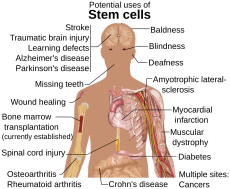
Stem cells are undifferentiated, which means they have the potential to develop into any type of cell. They have great potential both for medical research, and as possible cures for a range of diseases including Parkinson’s, Alzheimer’s, diabetes and heart disease. Some of the conditions for which stem cells are being investigated are shown in the diagram.
A stem cell’s ‘potency’ describes the number of different cell types which it can develop into, and depends on the source from which it is extracted. The two types of stem cell are adult and embryonic. Adult stem cells are present in every organ of the body, and remain undifferentiated until they are ‘activated’ by an injury or disease. At this point they can become any cell type from that organ, and can self-renew indefinitely to regenerate damaged tissues. Embryonic stem cells are found only in the very early stage of an embryo, in other words in the earliest stage of human life. These stem cells can differentiate into any cell type in the human body, and therefore have a much wider medical application. However, there are many ethical issues associated with using embryonic stem cells, as extracting the cells destroys the embryo.
There are a number of ways to extract stem cells. The method most commonly used today is thorough bone marrow extraction, typically carried out by drilling into the thigh bone or pelvis. The stem cells within bone marrow differentiate into all blood cells in the human body. Someone’s own bone marrow might be removed and frozen before they undergo treatment like chemotherapy, so that it can be put back in afterwards to regenerate healthy blood. The bone marrow from a healthy person might be transferred into someone suffering from diseases like leukaemia. Stem cells can also be taken out of the blood, or through liposuction.
Stem cells have many potential uses. If extracted they could be artificially grown and made to differentiate into specialised cells, forming tissue or even entire organs. Skin cells could be grown to treat serious burn victim. Those suffering from type 1 diabetes could have insulin-producing cells grown for them from their own stem cells. The regenerative properties of stem cells could be used to cure heart disease, or degenerative conditions like Parkinson’s. Entire human organs or volumes of blood could be grown in labs, solving the serious shortage that we have of both of these for a variety of medical treatments.
Research is also a key area for stem cells. New drugs can be tested on stem cells, thereby avoiding using human or animal test subjects. Studying how these undifferentiated cells become differentiated could hold important answers about medical conditions like cancer which are due to abnormal cell divisions.
Despite all of these benefits there are also a number of concerns associated with the use of stem cells. Campaigners are strongly opposed to the use of embryonic stem cells even for medical purposes. Although these are taken from lab-created embryos which are no more than four or five days old and just a ball of microscopic cells, some argue that because they have the potential to become human it is unethical to experiment on them. Even adult stem cells come with safety concerns, as some believe they could unwittingly pass viruses between patients or even turn cancerous.
Image: https://upload.wikimedia.org/wikipedia/commons/thumb/b/bd/Stem_cell_treatments.svg/2000px-Stem_cell_treatments.svg.png

0 Comment:
Be the first one to comment on this article.